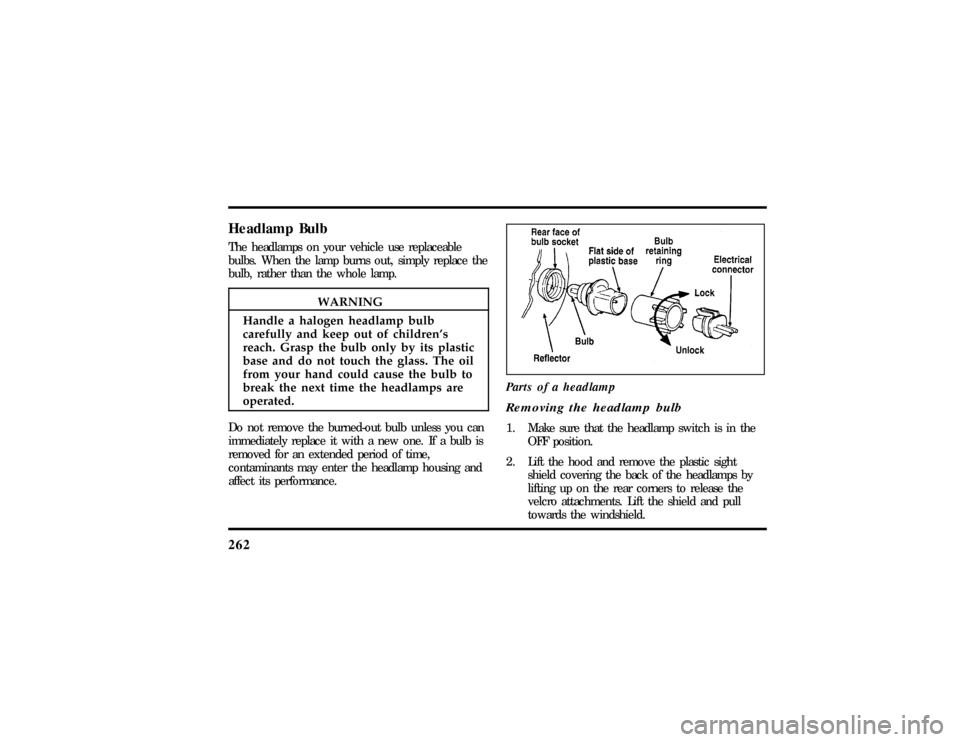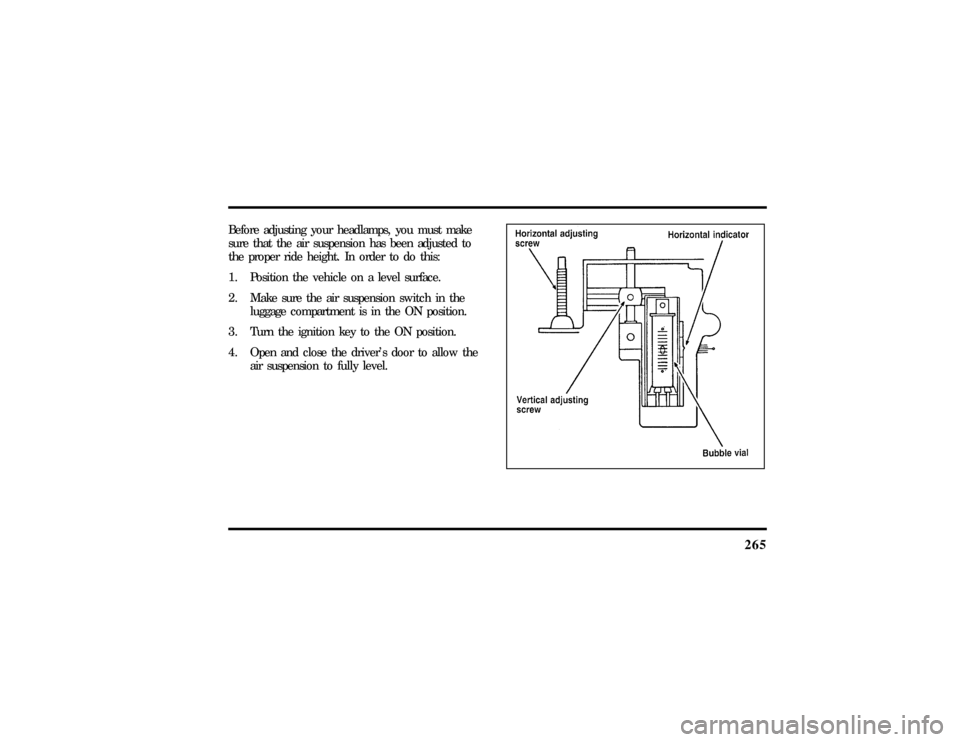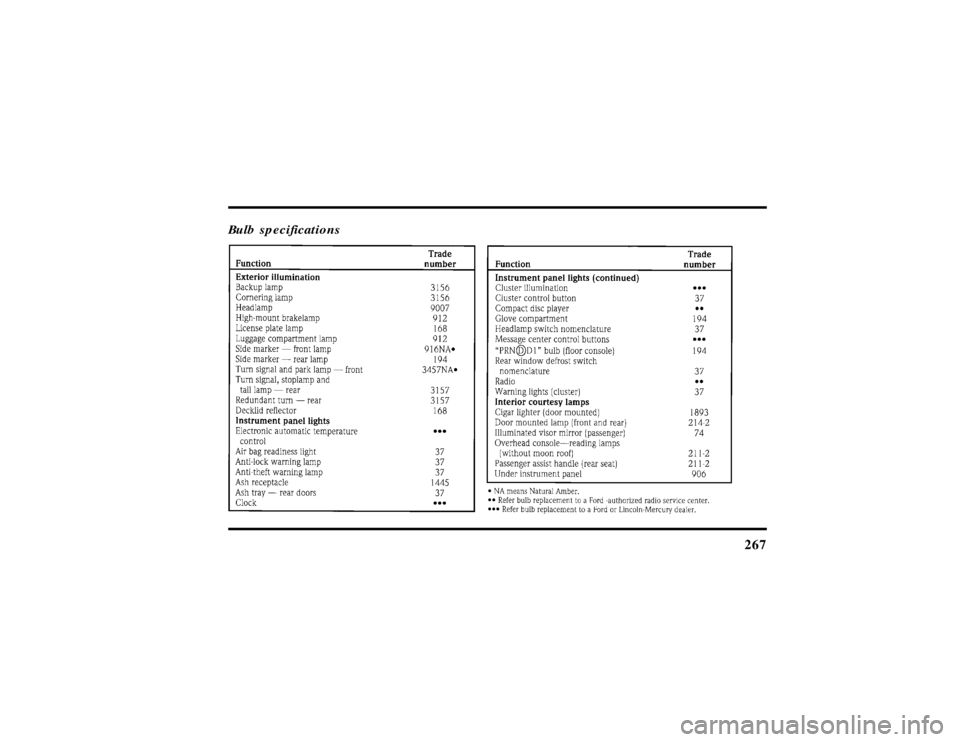LINCOLN CONTINENTAL 1997 Owners Manual
Manufacturer: LINCOLN, Model Year: 1997, Model line: CONTINENTAL, Model: LINCOLN CONTINENTAL 1997Pages: 321, PDF Size: 2.37 MB
Page 261 of 321

260Do not make any unauthorized changes to your
vehicle or engine. Changes that cause more
unburned fuel to reach the exhaust system can
increase the temperature of the engine or exhaust
system.
By law, anyone who manufactures, repairs, services,
sells, leases, trades vehicles, or supervises a fleet of
vehicles is not permitted to intentionally remove an
emission control device or prevent it from working.
In some of the United States and in Canada,
vehicle owners may be liable if their emission
control device is removed or is prevented from
working.
Do not drive your vehicle if it does not operate
properly. See your dealer if the engine runs on for
more than five seconds after you shut it off or if it
misfires, surges, stalls, or backfires.Information about your vehicle's emission control
system is on the Vehicle Emission Control
Information decal located on or near the engine.
This decal identifies engine displacement and gives
some tune-up specifications.
How to Prepare Your Vehicle for
Inspection/Maintenance (I/M) TestingIn some localities it may become a legal
requirement to pass an Inspection/Maintenance
(I/M) test of the On-Board Diagnostic (OBD) II
system. If the vehicle's powertrain system or its
battery has just been serviced, the OBD II system is
reset to a not ready for I/M testing condition. To
prepare for I/M testing, the law specifies that
additional mixed city and highway driving is
required to complete the check of the OBD II
system.
File:11fnmcc.ex
Update:Fri Sep 6 08:51:16 1996
Page 262 of 321

261
The driving modes required to reach the ready
condition consist of a minimum of 30 minutes of
city and highway driving as described below:q
At least twenty minutes driving in stop and go,
city type traffic with at least four idle periods.
q
At least ten minutes of driving on an
expressway or highway.
Before completing the above driving modes, the
engine must be warmed up and at operating
temperature. Once started, the vehicle must not be
turned off during these driving modes.
Lights and Bulb ReplacementIt is a good idea to check the operation of the
following lights frequently:q
headlamps
q
high-mount brakelamp
q
tail lamps
q
brakelamps
q
hazard flasher
q
turn signals
q
side markers
q
license plate lamps
The alignment of your headlamps should be
checked if:
q
oncoming motorists frequently signal you to turn
off your vehicle's high beams when you do not
have the high beams on
q
the headlamps do not seem to give you enough
light to see clearly at night
q
the headlamp beams are pointed substantially
away from a position slightly down and to the
right
File:11fnmcc.ex
Update:Fri Sep 6 08:51:16 1996
Page 263 of 321

262
HeadlampBulb
WARNING
Handl ea haloge nheadlam pbulb
Removin gth e headlam pbulb
Page 264 of 321

263
3. At the back of the headlamp, pull back and up
slightly on the two right angle brackets to
release the headlamp assembly from the
vehicle.
4. Carefully pull the headlamp assembly away
from the vehicle to expose the back of the bulb
and wiring connector.
5. Remove the electrical connector from the bulb
by grasping the wire with a quick pull
rearward.
6. Remove the retaining ring by turning it 1/8 of
a turn to free it from the socket. Then slide the
ring off the plastic base of the bad bulb.Keep
the ring.You must use it again to hold the
new bulb in place.
7. Carefully remove the bulb assembly from its
socket by gently pulling it rearward without
turning.
Installing the headlamp bulb1. With the flat side of the bulb's plastic base
facing upward, insert the glass end of the bulb
into the socket. You may need to turn the bulb
left or right to line up the grooves in the plastic
base with the tabs in the socket. When the
grooves are aligned, push the bulb into the
socket until the plastic base contacts the rear of
the socket.
2. Slip the bulb retaining ring over the plastic base
until it contacts the rear of the socket. Lock
the ring into the socket by rotating it clockwise
until you feel a ªstop.º
3. Push the electrical connector into the rear of
the plastic base until it snaps, locking it into
position.
4. Carefully position the headlamp assembly onto
the vehicle making sure the alignment pins are
inserted into the proper holes.
File:11fnmcc.ex
Update:Fri Sep 6 08:51:16 1996
Page 265 of 321

2645. Hold the headlamp assembly snugly against the
vehicle and push down on the right angle
brackets to lock the lamp into position.
6. Install the plastic sight shield.
7. Turn the headlamps on and make sure that
they work properly. If the headlamp was
correctly aligned before you changed the bulb,
you should not need to align it again.Aiming HeadlampsYour vehicle is equipped with a Vehicle Headlamp
Aim Device (VHAD) on each headlamp body. Each
headlamp may be properly aimed in the horizontal
direction (left/right) and the vertical position
(up/down).NOTE:A non-zero bubble reading does not
necessarily indicate out-of-aim headlamps. If your
vehicle is not positioned on a level surface, the
slope will be included in the level indicator.
Therefore, vertical headlamp adjustment should be
performed only when beam direction appears to be
incorrect or a level surface can be verified.
Tools required: One 4mm socket and ratchet.
The Horizontal aim must be adjusted first.
NOTE:The following procedure assumes that the
vehicle's front structure is in factory alignment
condition. If the vehicle has been in an accident
requiring the front end of the vehicle to be
repaired, the horizontal indicator should be
recalibrated by the servicing facility.
File:11fnmcc.ex
Update:Fri Sep 6 08:51:16 1996
Page 266 of 321

265
Before adjusting your headlamps, you must make
sure that the air suspension has been adjusted to
the proper ride height. In order to do this:
1. Position the vehicle on a level surface.
2. Make sure the air suspension switch in the
luggage compartment is in the ON position.
3. Turn the ignition key to the ON position.
4. Open and close the driver's door to allow the
air suspension to fully level.
File:11fnmcc.ex
Update:Fri Sep 6 08:51:16 1996
Page 267 of 321

266Horizontal aim adjustment1. Open the hood and lift the front end cover
from its velcro attachments. Locate the
horizontal level indicator and adjustment screw.
2. Use a 4mm socket and ratchet to turn the
horizontal adjusting screw until the horizontal
indicator is in line with the ª0º reference.
Vertical aim adjustmentNOTE:The numbers shown on the vial indicate
beam direction in degrees up or down.
1. Locate the vertical level indicator and
adjustment screw.
2. Use a 4mm socket and ratchet to turn the
vertical adjustment screw until the bubble in
the horizontal level indicator is centered in the
vial.
3. Replace the front end cover and close the
hood.
File:11fnmcc.ex
Update:Fri Sep 6 08:51:16 1996
Page 268 of 321

267
Bulb specifications
File:11fnmcc.ex
Update:Fri Sep 6 08:51:16 1996
Page 269 of 321

268Cleaning Your VehicleWashing and Polishing Your VehicleWash the outside of your vehicle, including the
underside, with a mild detergent.
DO NOT:q
Wash your vehicle with hot water
q
Wash your vehicle while it sits in direct
sunlight
q
Wash your vehicle while the body is hot
Pollen, bird droppings and tree sap can damage the
paint, especially in hot weather. Wash your vehicle
as often as necessary to keep it clean.
Take similar precautions if your vehicle is exposed
to chemical industrial fallout.Paint damage resulting from fallout is not related to
a defect inpaint materials or workmanship and
therefore is not covered by warranty. Ford,
however, believes that continual improvement in
customer satisfaction is a high priority. For this
reason, Ford has authorized its dealers to repair, at
no charge to the owner, the surfaces of new
vehicles damaged by environmental fallout within
12 months or 12,000 miles (20,000 km) of
purchase, whichever comes first. Customers may be
required to bring their vehicle in for inspection by a
Ford representative.
Polish your vehicle to remove harmful deposits and
protect the finish.
Cleaning Chrome and Aluminum PartsWash chrome and aluminum parts with a mild
detergent. Do not use steel wool, abrasive cleaners,
fuel, or strong detergents.
File:11fnmcc.ex
Update:Fri Sep 6 08:51:16 1996
Page 270 of 321

269
Cleaning Plastic PartsSome of your vehicle's exterior trim parts are
plastic. Clean with a tar and road oil remover if
necessary. Use a vinyl cleaner for routine cleaning.
Do not clean plastic parts with thinners, solvents or
petroleum-based cleaners.
If you have your vehicle rustproofed, remove
oversprayed rustproofing with a tar and road oil
remover. If rustproofing is not removed from plastic
and rubber parts, it can cause deterioration.Cleaning the Safety BeltsClean the safety belts with any mild soap solution
that is recommended for cleaning upholstery or
carpets. Do not bleach or dye the belt webbing
because this may weaken it.
Cleaning the Instrument Panel LensClean the instrument panel lens and woodtone trim
with a soft cloth and a glass cleaner. Do not use
paper towel or any abrasive cleaner to clean either
the lens or the woodtone trim as these may cause
scratches.Cleaning the Exterior LampsDo not use dry paper towel, chemical solvents or
abrasive cleaners to clean the lamps, as these may
cause scratches or crack the lamps.Cleaning the Interior LampsYour interior dome lamps and map lamps are plastic
and should be cleaned with a mild detergent
diluted in water. Rinse them with clear water.
File:11fnmcc.ex
Update:Fri Sep 6 08:51:16 1996